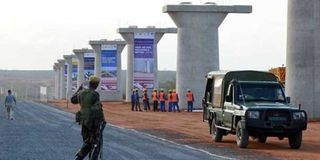In looking at ‘friendly’ Chinese loans, the devil is in the detail

The standard gauge railway under construction. An agreement for the $1.4 billion loan has been contracted from China Exim Bank to build the Nairobi-Naivasha segment of the standard gauge railway. PHOTO | FILE | NATION MEDIA GROUP
What you need to know:
- The loan is a 20-year facility with a grace period of five years and attracting interest rates of 3.5 per cent per annum.
- The agreement states that the government must make an upfront payment of an insurance premium of $222.4 million to the China Export Credit and Insurance Corporation.
- We are borrowing a total of $10 billion — the equivalent of 20 per cent of our gross domestic product — just for the SGR.
I received a lot of flak a few weeks ago when I expressed concerns about the rate at which we are gobbling up expensive Chinese loans, especially for the standard gauge railway, and how we were saddling unborn generations with these poorly- negotiated commercial debts.
My critics charged that the Chinese loans were no less expensive than the ones we have taken from institutions such as the World Bank and export credit agencies owned by Western governments.
I return to the debate, having acquired and combed through a copy of the signed agreement for the $1.4 billion loan we have contracted from China Exim Bank to build the Nairobi-Naivasha segment of the standard gauge railway (SGR).
Here are highlights of the terms of the loan agreement, which we signed with the Chinese on December 3, 2015. You would be wrong to treat this as the typical long-term loan with a generous grace period and fairly-priced interest rates.
The loan is a 20-year facility with a grace period of five years and attracting interest rates that calculate to about of 3.5 per cent per annum.
But, as the saying goes, the devil is in the detail. Included in the terms is a condition that interest is to be calculated in six-month periods instead of the conventional 12 months.
The implication is that over the 20-year period, the effective interest rate on this loan will be much higher.
Still, what makes the Chinese loan even more expensive is the cost of insurance. The agreement states that the government must make an upfront payment of an insurance premium of $222.4 million to the China Export Credit and Insurance Corporation.
Calculated, this figure comes to 15 per cent of the total contract amount. Effectively, this means that the Chinese take back 15 per cent of the loan amount upfront.
COMMITMENT FEE
There are two other significant terms in the loan agreement: a management fee of 0.5 per cent of the facility and a commitment fee on the undisbursed amount of 0.5 per cent, which must be cleared by the end of the grace period.
And the laws governing the agreement are the laws of China. Clearly, the Chinese are worse than the merchants of Venice — overloading us with high-priced loans and viciously promoting their exports by giving us more and more expensive export credit financing.
As I write, we are currently in the middle of new negotiations with Exim Bank of China to give us another $5 billion for the extension of the railway from Naivasha through Kisumu to Malaba on our border with Uganda.
In all, we are borrowing a total of $10 billion — the equivalent of 20 per cent of our gross domestic product — just for the SGR.
Couldn’t we get some of the money from elsewhere? The truth of the matter is that nobody is interested. Western creditors display little interest in funding what they consider to be slow-return risky long-term projects. Yet they will fall over one another for short-term projects.
I gather, for instance, that Western funding agencies have inundated the government with offers to finance the Nairobi commuter railway.
Is the SGR economically feasible? Doubts have been raised by a group of consultants called Africa 50, who have suggested in a report, that some segments — especially the line to the western parts of Kenya, may not generate enough traffic and are, therefore, not feasible. I take a different view.
HIGH CAPACITY PORT
The SGR is going to open up very huge sections of landlocked western Kenya to the rest of the country. Mark you, the line is being routed away from central Rift Valley. From Naivasha, it will go to Narok-Bomet-Kisumu-Yala-Bumula and finally Malaba.
In Kisumu, a new railway terminal is to be built consisting of a new fully-equipped high capacity port, a passenger station, and a freight exchange centre at a cost of $140 million with funds from Exim Bank of China.
It is being built as part of new transport infrastructure through Lake Victoria to link us to northern Tanzania and all the way to Kigali through the Kagera River. The thinking is that in the event Uganda drags its feet in developing its side of the SGR, we will still be able to reach the region through Lake Victoria.
What is my point? That once new infrastructure is in place, the people will find new and innovative ways of using it. The creator of the World Wide Web, Tim Bernes-Lee, would not have known things such as e-commerce and TV programme streaming would happen when he devised it to allow particle physicists to share information more easily.
In the long run, the SGR will make sense for the ordinary man and woman of western Kenya.





